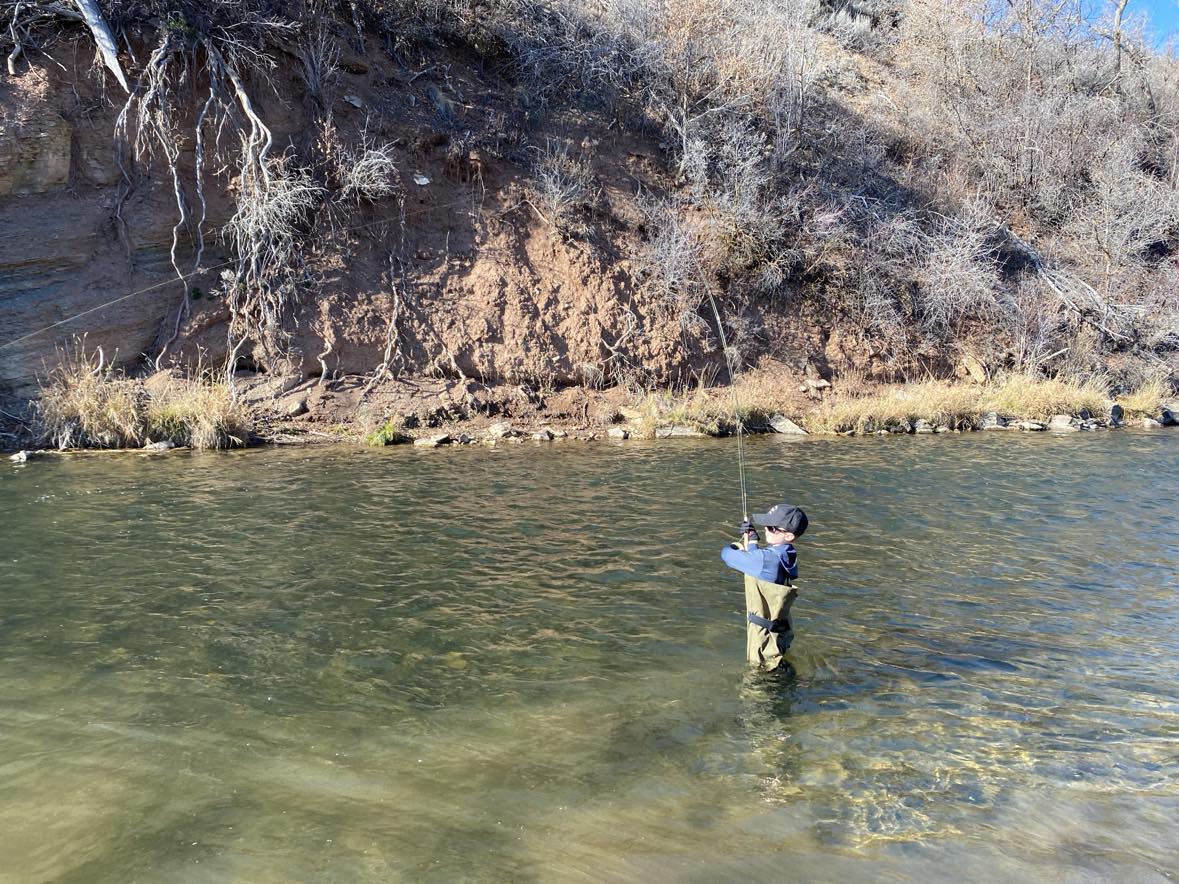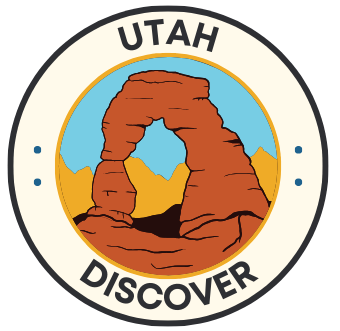The Wasatch Mountains are well known as the hotspot of mountain adventure in Utah. If you’re looking for a change of pace from all the adrenaline-filled activities, consider a day of fishing on the Provo River. It’s a place where the air feels fresher, the landscape seems to stretch endlessly into the horizon, and the rivers flow with promises of adventure. This was the backdrop to what would become one of our most memorable family outings – a fly fishing trip designed to introduce my eager 9-year-old son to this sport that’s now become his obsession. For anyone with a penchant for outdoor escapades, particularly families looking to bond over new experiences, the Provo River’s fly fishing scene is a treasure trove waiting to be explored.

Guided Fly Fishing on the Provo River
My son is completely obsessed with fishing and has been since he was just 5-years-old. Books, movies, and endless conversations about fishing fill our home. Each birthday wish list is topped with fishing gear, a testament to his unwavering interest. My husband and I, however, are novices in the world of fishing, and are actually pretty horrible at it. Realizing that while we live in a valley filled with some of the best fishing in Utah, we had to way to actually teach him how to fly fish. Luckily, there is no shortage of fly fishing guides in Park City and Heber Valley.
If you’re considering going fly fishing with kids, here’s a bit of advice: Not all guides are created equal, especially when it comes to kids. Fly fishing has its own language, and finding a guide who speaks “kid” is crucial. Make a few calls, ask about their experience with children, and plan ahead to snag the perfect guide.

After doing lots of research, we chose Park City Outfitters, based on their outstanding online reviews. We recognize that not all guiding companies are good with children, so this was one of our primary focuses. Our guide was a blend of educator, environmentalist, and fish whisperer, and instantly just clicked with my son when we met. He came with all the gear, equipping us with waders and boots while imparting wisdom about the ecosystems we were about to enter.

We did some on-shore practice and were finally ready to head into the water. With each cast, we grew more attuned to the rhythm of fly fishing. The initial awkwardness of our attempts gradually gave way to moments of triumph as we managed to catch a few fish, a testament to the patience and skill of our guide rather than our own skills. Our son was in heaven and was convinced he had almost outsmarted a dozen more fish that narrowly escaped. It was the perfect introduction to fly fishing.
Along the way, my husband and I peppered our guide with nonstop questions. We knew that regular guided trips were not in our budget, so it was our goal to learn as much as possible on this trip so that we could come back on our own to practice. Our guide was a GEM. He patiently answered our questions, gave us tips, and even shared some of his secret fishing holes for us to check out nearby. Not only did everyone have fun, but we walked away feeling empowered and knowing that we had learned enough to go out on our own to go fishing as a family.
What to Wear Fly Fishing
Dressing the part is key to being comfortable and having fun while fly fishing the Provo River with kids. Warm socks are a must – those waters are chilly, even in the summer! We always opt for wool socks because they’ll keep you warm even if they get a little bit wet. Sunglasses and a hat arealso really important. While they do make it easier to see, they also protect your head and eyes from stray hooks. Our guide was wonderful and had hats for both of us to wear, which I really appreciated.

Where to Fly Fish on the Provo River
The Provo River in Utah is renowned for its exceptional fly fishing opportunities, offering both beginners and seasoned anglers a chance to catch a variety of trout species in a stunning natural setting. The river flows through beautiful landscapes, including canyons, valleys, and the pastoral Heber Valley, before eventually finding its way into Utah Lake. It’s divided into three sections: the Lower Provo, the Middle Provo, and the Upper Provo, each offering unique fishing experiences and scenic beauty. While you are in Provo don’t forget to stop by BYU’s Monte L. Bean Museum Here’s a closer look at the best places to fly fish on the Provo River:
Upper Provo River

The Upper Provo River stretches from the headwaters in the Uinta Mountains to Jordanelle Dam. This section offers breathtaking views and a more secluded fishing experience. It’s only fishable in the summer and early fall when the water levels are high enough and when you can actually access the river (the Mirror Lake Highway is closed in the winter and Spring). The Upper Provo River is well-known for its high-density trout population, including native cutthroat and brook trout. It’s a great spot for those looking to enjoy the serenity of the mountains while fly fishing.
The highlight of fishing the Upper Provo River is the area around the Mirror Lake Highway which offers easy access to various parts of the river and a chance to catch large, aggressive trout. The Upper Provo is also less crowded compared to its downstream counterparts, making it a perfect choice for anglers who want to escape the crowds.
Middle Provo River

The Middle Provo River section runs from the Jordanelle Dam down to the Deer Creek Reservoir. It’s easily accessible from Park City and Heber Valley, making it a popular choice for both locals and visitors. The Middle Provo is famed for its year-round fly fishing, thanks to regulated flows from the Jordanelle Dam. It boasts a healthy population of brown and rainbow trout, with consistent hatches that provide excellent dry fly fishing opportunities.
The stretch of the Middle Provo River around River Road Bridge and Legacy Bridge in Midway is particularly popular, offering deep runs and pools teeming with trout. The Middle Provo also hosts a variety of aquatic insects, ensuring good fly fishing conditions throughout the year.
Lower Provo River

The Lower Provo River runs from the Deer Creek Reservoir to Utah Lake, as it winds through Provo Canyon, offering a mix of easy access points and more challenging, remote areas. The Lower Provo is known for its large and plentiful brown trout, with opportunities to catch trophy-sized fish. The river’s consistent flow and nutrient-rich waters support a vibrant ecosystem, making it an ideal spot for nymphing and dry fly fishing.
The section below Deer Creek Dam is highly regarded for its clear waters and abundant hatches, including midges, caddis, and mayflies. The “Boulder” stretch near Vivian Park is another hotspot, offering excellent fishing and beautiful canyon views.
Best Age to Go Fly Fishing With Kids
While the eager young ones might be ready to jump in at six, our guide suggested nine to ten as the ideal age. Patience, focus, and a bit of dexterity go a long way in fly fishing. At age 9, my son was a great age, though if he weren’t as obsessed with fishing, I think he would have done a little bit better around age 11.

For younger kids who want to go fishing, a day at the nearby Wasatch Mountain State Park, with its stocked pond and rental gear, might be the perfect introduction to fishing. Kids under 12 don’t need a fishing license, and with the large grassy area, ducks you can feed, and a playground, there’s plenty to keep kids engaged if the novelty of fishing wears off. We head here several times throughout the summer and the kids always love it.
Other Things to Do Nearby:
- Harvey Park Utah: Everything You Need To Know Before You Go
- Discovery (Manila) Park in Pleasant Grove
- Springville Splash Pad: Water Play with an Artistic Flare
- Best Utah Hikes with Kids
Best Fly Fishing Equipment for Kids

Selecting the right equipment is crucial to a child’s fly fishing success and enjoyment. It involves choosing gear that is size-appropriate and not overly complex. A lightweight, youth-sized fly rod and reel setup can make it easier for children to handle the equipment and learn the basics of casting without becoming frustrated. A rod around 7 to 8 feet in length for a 4 to 5 weight line is a good starting point for most kids.Protective clothing, including waders or waterproof boots, hats, and sunglasses, not only keeps them comfortable and safe from the elements but also protects against hooks and sun exposure. For younger kids, a life jacket can also be a good idea.
